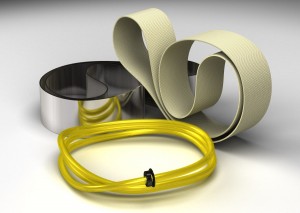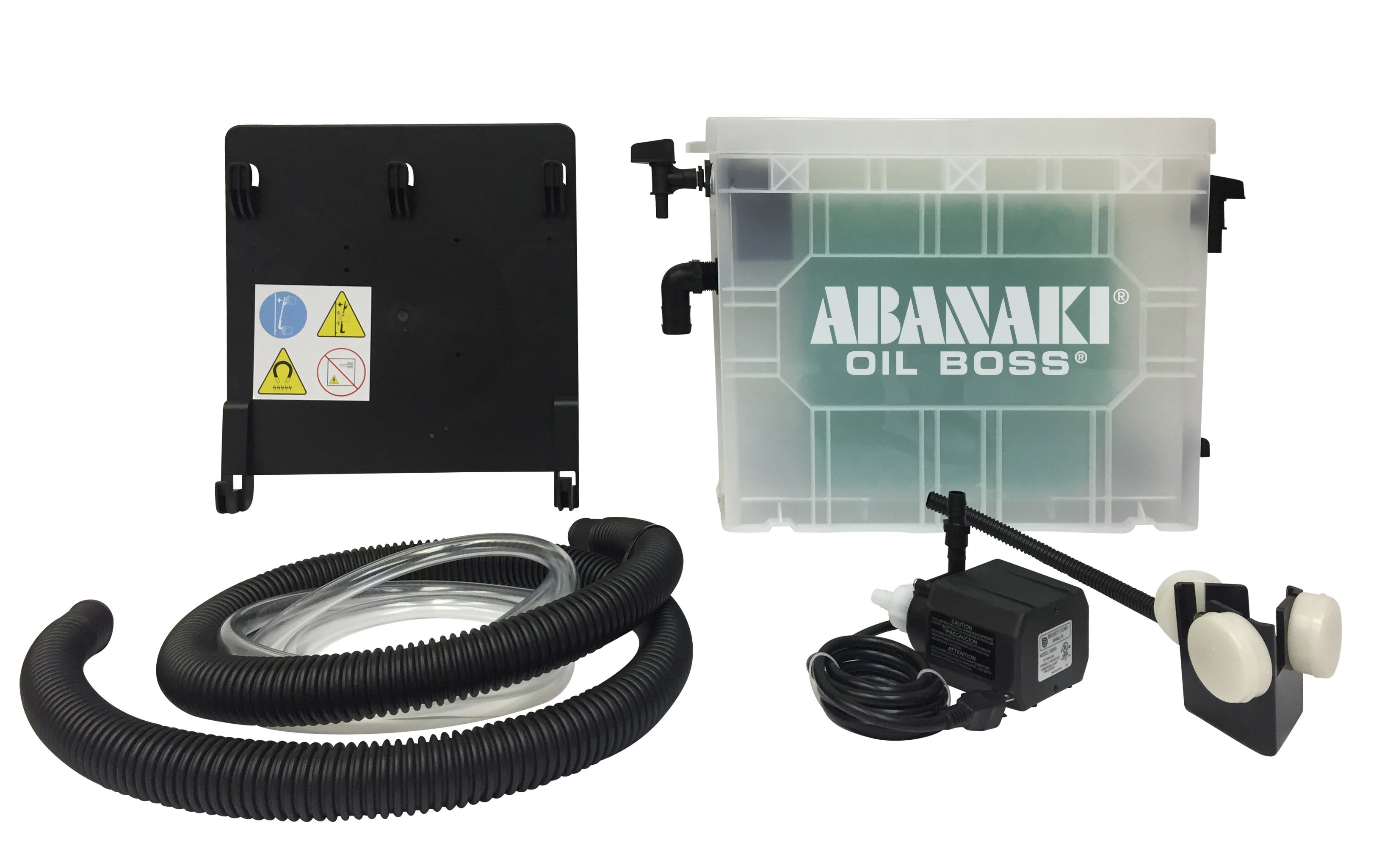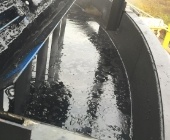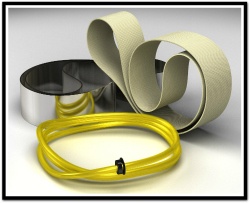Although designs vary, all oil skimmers rely on specific gravity, surface tension and a moving medium to remove floating oil from a fluid’s surface.
Topics: oil skimmers, belt skimmer, belt materials, belt oil skimmer
Tramp Oil Collection: Coalescers vs Oil Skimmers | Abanaki
Multiple options exist for the collection of tramp oils. Two of the most common are oil skimmers and coalescers. Both offer unique advantages and disadvantages in certain applications.
Coalescers
Coalescers focus on collecting oil into larger droplets. Using a filter medium, the oil is gathered into one place and combines into a larger oil droplet, heightening the differing densities of oil and water. The oil then floats to the top of the coalescer, allowing removal by other means.
Coalescers have an advantage in specific coolant-related applications. Coalescers cover a bigger collection area than oil skimmers, speeding recovery and reducing need for moving the oil collection device.
Unlike oil skimmers, coalescers have no need for a collection container, preventing the potential for spillage. Abanaki's Oil Boss can also be hung from a metallic surface, preventing the floor space footprint of other coalescers and oil skimmers.
Oil Skimmers
Oil skimmers focus on removing tramp oils using oleophilic belts. These belts attract the tramp oils and drag them up to a trough where they are scraped off, removing them from the water or coolant. Different belts have different specialties, such as steel belts being suited for LNAPLs and tramp oils.
Oil skimmers have an advantage in more varied conditions. Able to be used in high temperature applications where plastic coalescers might face pump failures, oil skimmers can withstand more extreme environments.
In addition, oil skimmers do not have to worry about pumps clogged by shavings or solid byproducts like coalescers might. Dirty oil can also go back into the sump in coalescers, while oil is completely removed by a oil skimmer. Oil skimmers also have more applications than coalescers, such as environmental remediation.
For more information about our line of coalescers and oil skimmers, take a look at our product catalog using the button below, or contact us via phone at (440) 543-7400 or via e-mail at skimmers@abanaki.com.
Topics: oil skimmers, belt skimmer, belt materials, coolescer, belt oil skimmer, coalescers
Selecting the right belt material is just as important as selecting the right skimmer. Choose the wrong belt and the skimmer will not work correctly. Things like pH, temperature, and oil type are crucial considerations.
Purpose of Oil Skimmer Belts
Selecting the right belt material is just as important as selecting the right skimmer. You might choose the right skimmer but the wrong belt type and the skimmer will not work correctly to solve your oil in water problem. It is crucial that things like pH, temperature, and oil type are considered when selecting a skimmer AND a belt type.
A belt is to a skimmer like wheels to a car’s chassis: although the latter is the most identifiable part, it needs the former to actually run. Just like tires, belts are not one size fits all. Just as there are snow tires, street tires, year-round tires, and more, so too are there a variety of belt materials. So, what purpose does each serve?
Different Kind of Oil Skimmer Belt Materials
There is a great deal of variance in applications where belt oil skimmers are present. Figuring out what would be the best belt material for your belt skimmer will depend on a few factors. For the most part, belts pick up the oil in the same fashion so the big difference is finding what will give you the longest operating life.
Steel Belts
Steel belts are the standard for many applications. Their durability, corrosion resistance, and strong oleophilic tendencies make the material effective in most scenarios. The lower price and ease of welding also reduce costs. The biggest caveat is their ineffectiveness when confronted with rust inhibitors in wash water. Steel belts are also ineffective in most applications where Petro-Xtractors are used.
Elastomer Belts
Elastomer belts are an alternative to steel belts that perform well in a multitude of situations. These belts can handle some of the harshest, most abrasive conditions a skimmer can be placed in and are fully compatible with the Petro-Xtractor. Still, steel belts will not stretch when exposed to UV rays over a long period of time.
Polymer (Poly) Belts
Polymer belts, commonly shortened to poly belts, are meant for higher temperatures and conditions where UV exposure and rust inhibitors are an issue. The textured nature of the poly belts causes more oil than usual to be picked up. This option tends to be pricier, but works like a charm in intense functions.
Fuzzy Belts
This video demonstrates how choosing the right belt material makes all of the difference. The Fuzzy belt does a better job at picking up the hydrocarbon than the standard belt on the right.
LFO belts, commonly referred to as Fuzzy belts, are a proprietary skimmer belt exclusive to Abanaki. This material specializes in the rapid removal of light, non-viscous hydrocarbons from water. If your problem is an oil like gasoline, the Fuzzy belt will remove it much more efficiently than any other belt in normal conditions. The Fuzzy belts are also extremely resistant to stretching.
XP Polymer (Poly) Belts
XP polymer belts, commonly shortened to XP poly belts, are very similar to poly belts. The key difference comes in its texture and temperature resistance. The XP poly belt is better able to handle high temperatures, maxing out at 180ºF. The belt also has a smooth texture rather than the ridged design of the standard poly belt. Although this change means the XP poly belt will not pick up oil as quickly, the belt will function better than the standard poly belt in conditions that would wear away the ridged design.
More information can be found in the Abanaki Oil Skimmer Factbook or Abanaki Belt Selection Guidebook. It is best to call (440-543-7400) with details of the application and ask your Abanaki representative what will work best with your belt skimmer.
Topics: oil skimmers, belt skimmer, belt materials, belt oil skimmer
3 Tank Characteristics to consider in Choosing Oil Skimmers
Choosing an oil skimmer best suited for your application will maximize oil removal while minimizing capital and operational costs. The impoundment capacity, shape, and location of a tank and water impoundment are major factors in choosing the right oil skimmer to lower your costs.
- Size/Design:
It is critical that oil in the water is given the opportunity to separate. Oil and water can emulsify when subjected to turbulence and other mechanical agitation. Avoid this by having water return to the tank below the liquid surface at as low a velocity as practical. Make sure your tank or sump provides quiet areas, weirs, and sufficient volume to allow adequate time for oil/water separation. - Shape:
Tanks without nooks and crannies for oil to get stuck in are best. If you have an irregular shape, put the oil skimmer where the largest amount of oil accumulates. Consider a means of directing oil towards the oil skimmer such as a floating boom or baffle plate. - Location/Installation:
The physical location and characteristics of the tank and collection container are important and it is vital to ask the right questions such as:- Does skimmed oil need to be pumped from the oil skimmer to the container?
- Will oil skimmer access for periodic maintenance be a problem?
- How much mounting space is available?
- Are tank or container modifications required?
If you need any help choosing the right to put a skimmer, our experts are ready to help. Give us a call at 1-440543-7400 or to learn more about which skimmers work better in specific tanks or sumps, click below.
Topics: coolant, belt selection guide, oil skimmer belt, belt materials, oil skimmer, tank
Oil Skimming Myths Exposed! Get the Facts and Real Tips!
Fact:
Oil skimming makes use of the differences in specific gravity and surface tension between oil and water. These physical characteristics allow the belt to attract grease, oil, and other hydrocarbon liquids from the far side of the tank.
Oil Skimming Tip:
When selecting an oil skimmer, be sure to place the skimmer where oil is already gathering. This will ensure the quickest removal of the oil.
Fact:
Belt oil skimmers and oil skimming will collect all types of oil including all free-floating oils, LNAPLS, DNAPLS, and some emulsified oils. The various belt materials allow for any type of hydrocarbon removal.
Oil Skimming Tip:
There are several things to consider when choosing a belt for your oil skimmer. For example, some plastics won’t stand up to heat or strong chemicals, some metal belts won’t skim well from coolants due to rust inhibitors being present and certain plastic belts don’t last in heated applications. It is very important to choose a good oil skimmer vendor that offers a wide variety of belts to handle any situation. Equally important is to inform them of the details of your application so they can provide assistance in choosing the proper belt material at the start.
Get the Abanaki Interactive Oil Skimming Selection Guide to find the right skimmer for you.
Topics: coolant, belt selection guide, oil skimmer belt, belt materials, oil skimmer
Make your March the better Month: 11 Tips for Effective Skimming!
Companies always look for effective ways to remove oil from water or coolant. Here are the 11 easy tips to skim oil from water or coolant.
Topics: oil belt skimmer, oil skimming, belt materials, wiper blade
A belt is to a skimmer like wheels to a car’s chassis: although the latter is the most identifiable part, it needs the former to actually run. Just like tires, belts are not one size fits all. Just as there are snow tires, street tires, year-round tires, and more, so too are there a variety of belt materials. So what purpose does each serve?
Topics: belt selection guide, oil skimmer belt, belt materials, oil skimmer, belt material
Topics: oil skimmers, belt skimmer, oil skimming, belt materials, abanaki, tube skimmer










.jpg)

